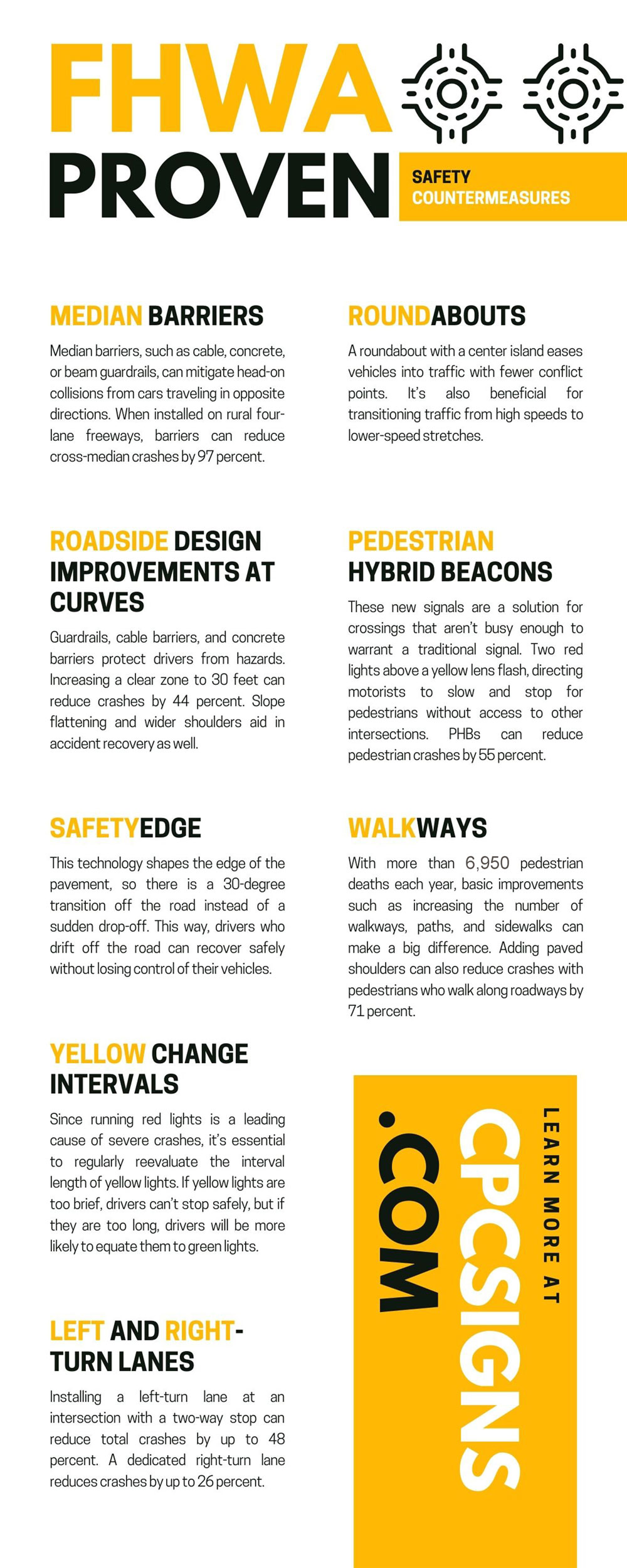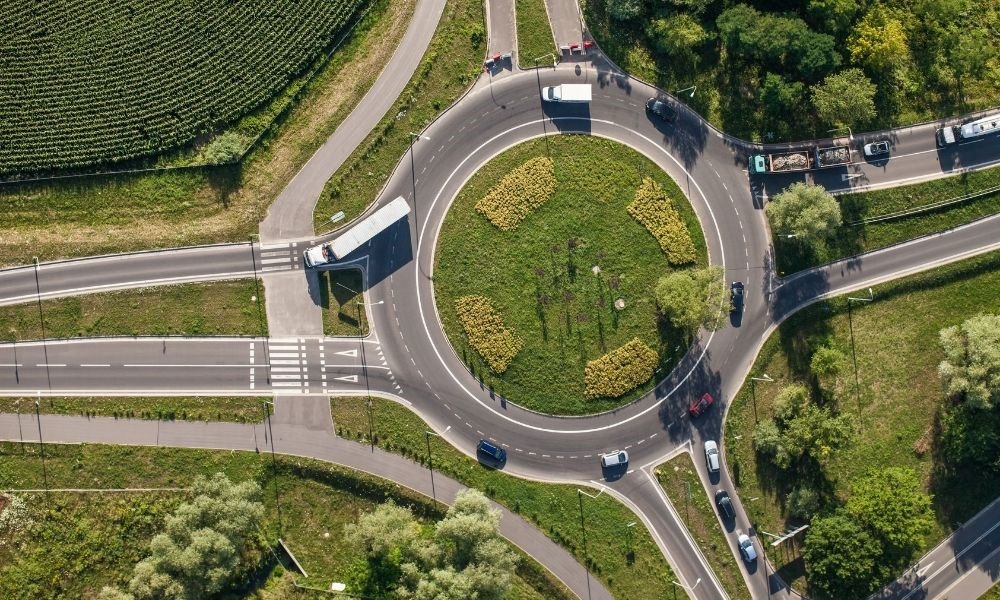Since 2008, the Federal Highway Administration has recommended these strategies to reduce injuries and fatalities on roads. Some are common-sense, low-cost improvements, while others capitalize on innovative technology. The FHWA Proven Safety Countermeasures are updated regularly, as are the safety statistics for each.
Roadway Departure
Median Barriers
Median barriers, such as cable, concrete, or beam guardrails, can mitigate head-on collisions from cars traveling in opposite directions. When installed on rural four-lane freeways, barriers can reduce cross-median crashes by 97 percent.
Roadside Design Improvements at Curves
Guardrails, cable barriers, and concrete barriers protect drivers from hazards. Increasing a clear zone to 30 feet can reduce crashes by 44 percent. Slope flattening and wider shoulders aid in accident recovery as well.
Recommendations for Horizontal Curves
A variety of methods can increase safety for horizontal curves on roads. Just adding highly visible, chevron warning signs can reduce nighttime crashes by 25 percent. Other suggestions include:
- Pavement markings
- Post-mounted guides
- Larger signs and enhanced retroreflectivity
- Dynamic advance curve warning signs and sequential curve signs
- High-friction surface treatments that reduce wet road crashes by 52 percent
Rumble Strips
Vehicles that drift out of their lanes because of distracted, drowsy, or inattentive drivers account for more than half of the fatal crashes in the United States. Pavement bumps cause vehicles to vibrate when they’ve departed from the road and can reduce head-on and sideswipe crashes by up to 64 percent. When combined with rumble stripes (pavement markings like bright white paint), they are even more effective because they provide increased visibility, especially during wet, dark conditions.
SafetyEdge
This technology shapes the edge of the pavement, so there is a 30-degree transition off the road instead of a sudden drop-off. This way, drivers who drift off the road can recover safely without losing control of their vehicles. SafetyEdge can reduce dangerous crashes by 11 percent.
Intersections
Yellow Change Intervals
Since running red lights is a leading cause of severe crashes, it’s essential to regularly reevaluate the interval length of yellow lights. If yellow lights are too brief, drivers can’t stop safely, but if they are too long, drivers will be more likely to equate them to green lights. Well-timed yellow lights can reduce crashes by up to 14 percent.
Backplates With Retroreflective Borders
Just adding a bright yellow border around traffic signals can make them harder to ignore, reducing crashes by 15 percent.
Corridor Access Management
Strategically controlling the entry and exit points along a roadway can significantly improve safety and traffic flow. These techniques include lower-speed arteries off busier roads, raised medians to prevent cars from crossing traffic, and even one-way driveways for business along the road.
Left and Right-Turn Lanes
Installing a left-turn lane at an intersection with a two-way stop can reduce total crashes by up to 48 percent. A dedicated right-turn lane reduces crashes by up to 26 percent.
Reduced Left-Turn Conflict Intersections
New geometric designs for intersections can help prevent confusion for left-turning vehicles. Median U-turns reduce intersection injuries by 30 percent; restricted crossing U-turns reduce injuries and fatalities by 54 percent.
Roundabouts
A roundabout with a center island eases vehicles into traffic with fewer conflict points. It’s also beneficial for transitioning traffic from high speeds to lower-speed stretches. Converting a two-way stop into a roundabout can reduce severe crashes by 82 percent.
Additional Low-Cost Countermeasures
Systemically applying a group of low-cost strategies can reduce injuries and fatal crashes by 10 percent at stop-controlled intersections. The measures are as simple as using two oversized stop signs and removing vegetation that blocks warning signs.
Pedestrians and Bicyclists
Walkways
With more than 50,000 pedestrian deaths each year, basic improvements such as increasing the number of walkways, paths, and sidewalks can make a big difference. Adding paved shoulders can also reduce crashes with pedestrians who walk along roadways by 71 percent.
Medians and Crossing Islands
These features can give pedestrians a breather when crossing roads, breaking down the crossing for each direction of traffic. Despite what traffic signals say, pedestrians have to use their own judgment to:
- Estimate vehicle speeds
- Adjust their walking speed
- Determine gaps in traffic
- Predict the paths of oncoming vehicles
In urban and suburban areas, adding raised medians can reduce pedestrian crashes by 46 percent, while pedestrian crossing islands reduces them by 56 percent.
Leading Pedestrian Intervals
Giving pedestrians a three to seven-second head start into intersections can help establish their priority over vehicles turning left and can reduce related crashes by 13 percent.
Road Reconfigurations
A road reconfiguration—also known as a “diet”—converts a four-lane undivided roadway to three lanes, with the center lane dedicated to turning. It can reduce overall crashes up to 47 percent.
Pedestrian Hybrid Beacons
These new signals are a solution for crossings that aren’t busy enough to warrant a traditional signal. Two red lights above a yellow lens flash, directing motorists to slow and stop for pedestrians without access to other intersections. PHBs can reduce pedestrian crashes by 55 percent.
Crosscutting
Local Road Safety Plans
Local roads have three times the fatalities of the interstate highway system, but a customized LRSP prioritizes issues, risks, actions, and improvements for safety. Agencies at the county, state, and federal levels need to collaborate to capitalize on all expertise and resources. The emphasis should be on the four E’s: engineering, enforcement, education, and emergency medical services.
Road Safety Audits
Most transportation agencies already have review procedures in place, but an independent audit can reduce up to 60 percent of crashes for a road or intersection. A multidisciplinary team considers all road users and capabilities and accounts for human factors. The audit is documented in a report that requires a formal response from the road owner.
USLIMITS2
This free online tool uses engineering studies to recommend speed limits for specific stretches of road. It relies on data such as:
- 50th and 80th percentile speeds
- Traffic volume
- Roadway type
- Roadway setting
- Number of access points
- Crash history
- Pedestrian and bicyclist activity
The resulting speed recommendations balance safety, consistency, and feasibility. Transportation departments use USLIMITS2 to gain an objective second opinion.
At Custom Products Corporation, we make highway traffic signs and other tools that adhere to the FHWA’s Proven Safety Countermeasures. Since 1985, we’ve been building our experience with the latest products for up-to-date regulations. Contact us for more information.






